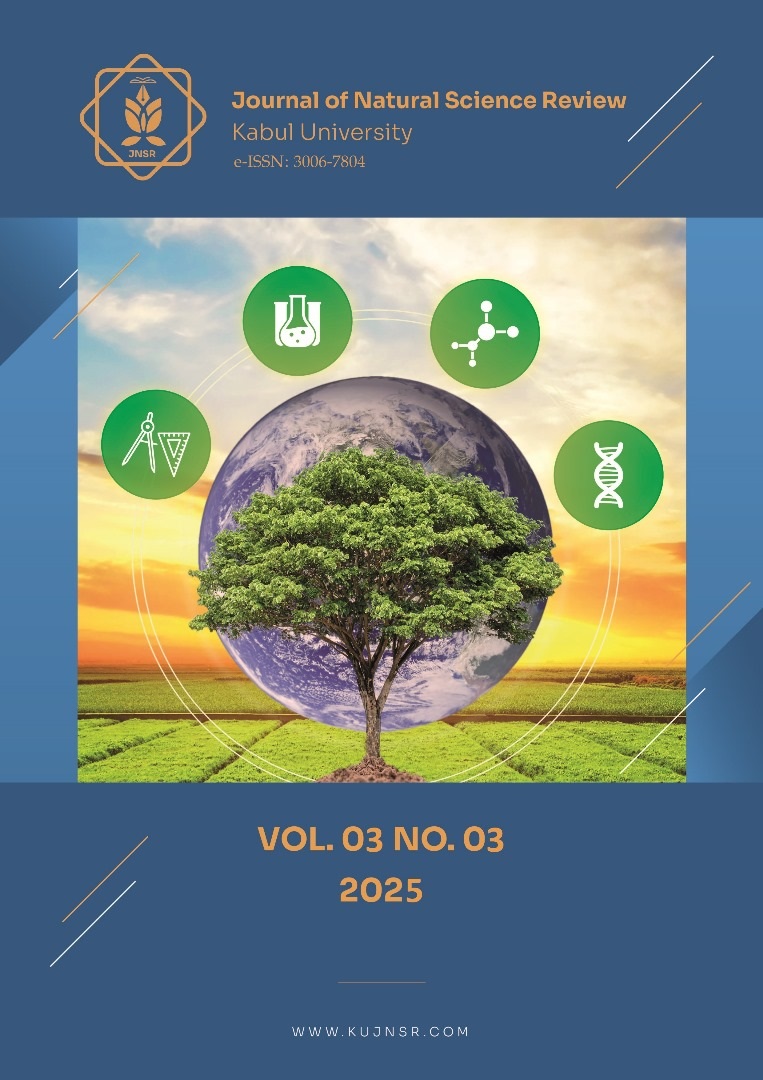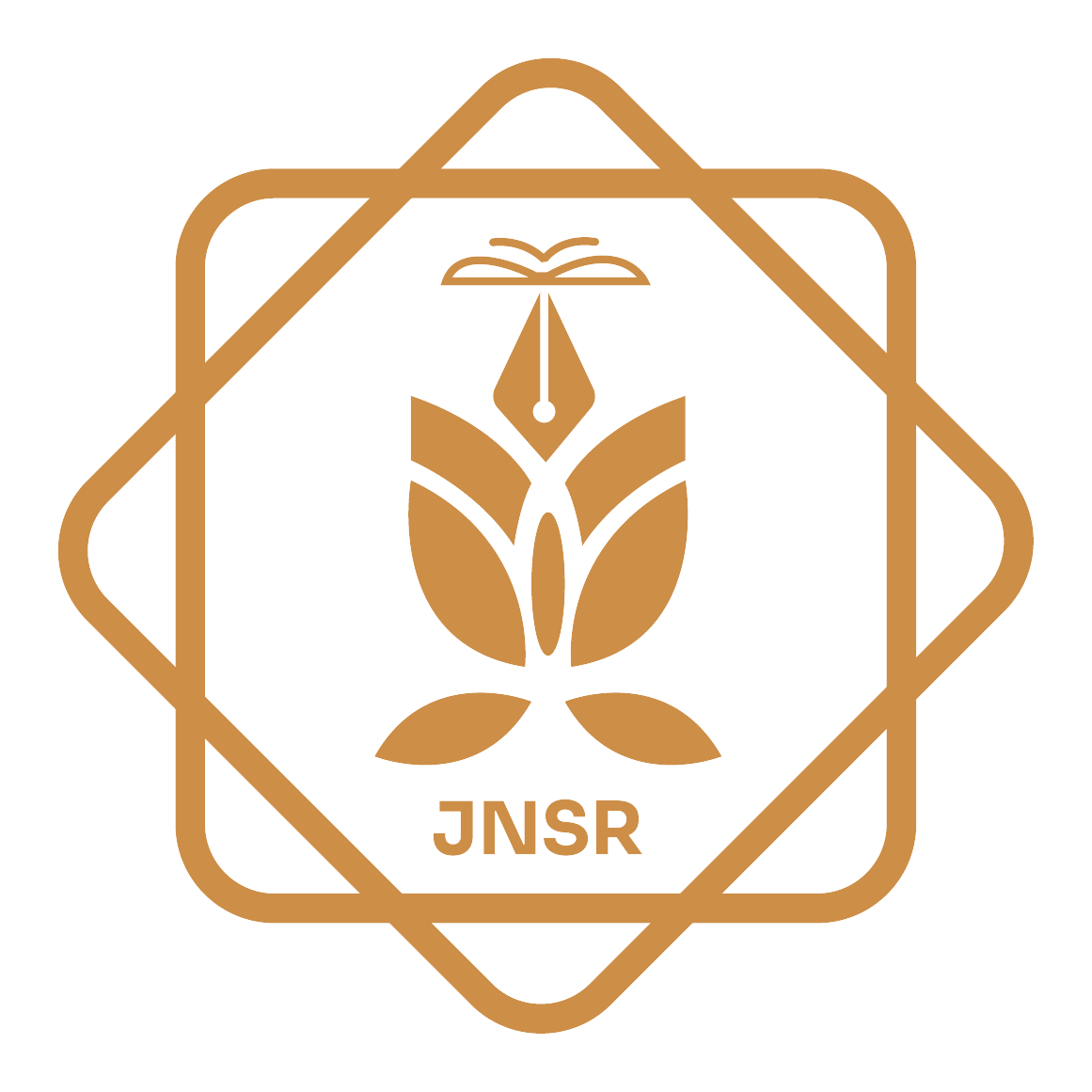The COVID-19 lockdown impact on air quality: A Case Study of Two Districts in Kabul City, Afghanistan
DOI:
https://doi.org/10.62810/jnsr.v3i3.238Keywords:
Air quality, Air pollutants, COVID-19, LockdownAbstract
The COVID-19 pandemic spread rapidly worldwide, causing millions of deaths. To curb transmission, many countries imposed lockdowns, leading to a noticeable improvement in air quality. During the peak of the pandemic, Kabul, Afghanistan’s capital and one of the world’s most polluted cities, enforced a three-month lockdown. This study evaluates the impact of the lockdown on Kabul’s air quality by analyzing variations in pollutant concentrations (PM₂.₅, PM₁₀, CO, NO₂, SO₂, and O₃) across two districts before and during the lockdown. Air quality data from the National Environmental Protection Agency was evaluated using a paired-samples t-test. The results revealed a significant decline in pollution levels. Pre-lockdown, Kabul’s air quality was severely degraded, with PM₂.₅ (334–362 µg/m³) and PM₁₀ (491–518 µg/m³) exceeding standards by 4.5× and 3×, respectively, while NO₂ peaked at 565 µg/m³ (7× the limit). During Lockdown, concentrations of PM₂.₅, PM₁₀, NO₂, and SO₂ dropped, nearing permissible levels. This suggests that reduced human activities lead to cleaner air. These findings highlight the benefits of strategic emission controls, offering policymakers actionable insights for improving Kabul’s air quality.
Downloads
References
Burnett, R.T., et al. (2014). Global estimates of mortality associated with long-term exposure to outdoor delicate particulate matter. Proceedings of the National Academy of Science, 111(32), 14701-14706. https://doi.org/10.1073/pnas.1803222115 DOI: https://doi.org/10.1073/pnas.1803222115
Cohen, A. J., Brauer, M., Burnett, R., Anderson, H. R., Frostad, J., Estep, K., & Forouzanfar, M. H. (2017). Estimates and 25-year trends of the global burden of disease attributable to ambient air pollution: an analysis of data from the Global Burden of Diseases Study 2015. The Lancet, 389(10082), 1907-1918. https://doi.org/10.1016/S0140-6736(17)30505-6 DOI: https://doi.org/10.1016/S0140-6736(17)30505-6
Cui J, Li F, Shi ZL (2019). Origin and evolution of pathogenic coronaviruses. Nature Reviews Microbiology 17(3):181-192. https://doi.org/10.1038/s41579-018-0118-9 DOI: https://doi.org/10.1038/s41579-018-0118-9
Dutheil, F., Baker, J. S., & Navel, V. (2020). COVID-19 as a factor influencing air pollution? Environmental pollution, 263, 114466. https://doi.org/10.1016/j.envpol.2020.114466 DOI: https://doi.org/10.1016/j.envpol.2020.114466
Fu, F., Purvis-Roberts, K. L., & Williams, B. (2020). Impact of the COVID-19 pandemic lockdown on air pollution in 20 major cities around the world. Atmosphere, 11(11), 1189. https://doi.org/10.3390/atmos11111189 DOI: https://doi.org/10.3390/atmos11111189
Gautam, S. (2020). COVID-19: Air pollution remains low as people stay at home. Air Quality, Atmosphere & Health, 13, 853–857. DOI: https://doi.org/10.1007/s11869-020-00842-6
Government of the Islamic Republic of Afghanistan. State of Afghan Cities; UN-Habitat: Kabul, Afghanistan, 2015; Volume 1.
He, M. Z., Kinney, P. L., Li, T., Chen, C., Sun, Q., Ban, J.. & Kioumourtzoglou, M. A. (2020). Short-and intermediate-term exposure to NO2 and mortality: a multi-county analysis in China. Environmental Pollution, 261, 114165. https://doi.org/10.1016/j.envpol.2020.11416 DOI: https://doi.org/10.1016/j.envpol.2020.114165
Kampa, M., & Castanas, E. (2008). Human health effects of air pollution. Environmental pollution, 151(2), 362-367. https://doi.org/10.1016/j.envpol.2007.06.012 DOI: https://doi.org/10.1016/j.envpol.2007.06.012
Kennes, C., & Veiga, M. C. (2013). Introduction to air pollution. Air Pollution Prevention and Control: Bioreactors and Bioenergy, 1-18. https://doi.org/10.1002/9781118523360.ch1 DOI: https://doi.org/10.1002/9781118523360.ch1
Kitamura, Y., Karkour, S., Ichisugi, Y., & Itsubo, N. (2020). Evaluation of the economic, environmental, and social impacts of the COVID-19 pandemic on the Japanese tourism industry. Sustainability, 12(24), 10302. https://doi.org/10.3390/su122410302 DOI: https://doi.org/10.3390/su122410302
Kumari, P., & Toshniwal, D. (2020). Impact of Lockdown on air quality over major cities across the globe during COVID-19 pandemic. Urban climate, 34, 100719. https://doi.org/10.1016/j.uclim.2020.100719 DOI: https://doi.org/10.1016/j.uclim.2020.100719
Lenzen, M., Li, M., Malik, A., Pomponi, F., Sun, Y. Y., Wiedmann, T., & Yousefzadeh, M. (2020). Global socioeconomic losses and environmental gains from the Coronavirus pandemic. PloS one, 15(7), e0235654. https://doi.org/10.1371/journal.pone.0235654 DOI: https://doi.org/10.1371/journal.pone.0235654
Muhammad, S., Long, X., & Salman, M. (2020). COVID-19 pandemic and environmental pollution: A blessing in disguise?. Science of the total environment, 728, 138820. https://doi.org/10.1016/j.scitotenv.2020.138820 DOI: https://doi.org/10.1016/j.scitotenv.2020.138820
Pal, S. C., Chowdhuri, I., Saha, A., Ghosh, M., Roy, P., Das, B., ... & Shit, M. (2022). COVID-19 strict lockdown impact on urban air quality and atmospheric temperature in four megacities of India. Geoscience frontiers, 13(6), 101368.https://doi.org/10.1016/j.gsf.2022.101368 DOI: https://doi.org/10.1016/j.gsf.2022.101368
Perlman S (1998). Pathogenesis of coronavirus-induced infections. In Coronaviruses and Arteriviruses (pp. 503-513). Springer, Boston, MA. https://doi.org/10.1007/978-1-4615-5331-1_65 DOI: https://doi.org/10.1007/978-1-4615-5331-1_65
Persinger, R. L., Poynter, M. E., Ckless, K., & Janssen-Heininger, Y. M. (2002). Molecular mechanisms of nitrogen dioxide-induced epithelial injury in the lung. Molecular and cellular biochemistry, 234, 71-80. DOI: https://doi.org/10.1007/978-1-4615-1087-1_8
Rasouli, H. (2022). Climate change impacts on water resource and air pollution in Kabul Sub-basins, Afghanistan. Advances in Geological and Geotechnical Engineering Research, 4(1), 11-27. https://doi.org/10.30564/agger.v4i1.4312
Rasouli, H. (2022). Climate change impacts on water resource and air pollution in Kabul Sub-basins, Afghanistan. Advances in Geological and Geotechnical Engineering Research, 4(1), 11-27.: https://doi.org/10.30564/agger.v4i1.4312 DOI: https://doi.org/10.30564/agger.v4i1.4312
Sediqi, A., & PG, I. (2010). A preliminary assessment of air quality in Kabul. reason, 250, 767-792.
Sharma, S., Zhang, M., Gao, J., Zhang, H., & Kota, S. H. (2020). Effect of restricted emissions during COVID-19 on air quality in India. Science of the total environment, 728, 138878. https://doi.org/10.1016/j.scitotenv.2020.138878 DOI: https://doi.org/10.1016/j.scitotenv.2020.138878
Shrestha, A. M., Shrestha, U. B., Sharma, R., Bhattarai, S., Tran, H. N. T., & Rupakheti, M. (2020). The lockdown caused by the COVID-19 pandemic has reduced air pollution in cities worldwide. https://doi.org/10.31223/osf.io/edt4j DOI: https://doi.org/10.31223/OSF.IO/EDT4J
Singh, V., Singh, S., Biswal, A., Kesarkar, A. P., Mor, S., & Ravindra, K. (2020). Diurnal and temporal changes in air pollution during COVID-19 strict Lockdown over different regions of India. Environmental Pollution, 266, 115368. https://doi.org/10.1016/j.envpol.2020.115368 DOI: https://doi.org/10.1016/j.envpol.2020.115368
Talukdar, A., Bhattacharya, S., Pal, S., Pal, P., & Chowdhury, S. (2024). Positive and negative impacts of COVID-19 on the environment: A critical review with sustainability approaches. Hygiene and Environmental Health Advances, 12, 100107. https://doi.org/10.1016/j.heha.2024.100107 DOI: https://doi.org/10.1016/j.heha.2024.100107
Torabi, E., & Nogami, A. (2016). Environmental assessment of suspended particulate matter over the Kabul City, Afghanistan. In Proc. 44th Annual Meeting of Environmental Systems Research, Conference of Japan Society of Civil Engineers, Tokyo Metropolitan University, Tokyo, Japan
Tosepu, R., Gunawan, J., Effendy, D. S., Lestari, H., Bahar, H., & Asfian, P. (2020). Correlation between weather and COVID-19 pandemic in Jakarta, Indonesia. Science of the total environment, 725, 138436.https://doi.org/10.1016/j.scitotenv.2020.138436 DOI: https://doi.org/10.1016/j.scitotenv.2020.138436
Usmani, A., Baseer, A. Q., Rahimi, B. A., Jahid, A., Niazi, P., Monib, A. W., & Lali, W. M. (2020). Coronavirus disease 2019 (COVID-19) pandemic: What is the level of knowledge, attitude, and practice in Kandahar, Afghanistan. African Journal of Microbiology Research, 14(9), 465-470. https://doi.org/10.5897/AJMR2020.9369 DOI: https://doi.org/10.5897/AJMR2020.9369
Wang, Q., & Su, M. (2020). A preliminary assessment of the impact of COVID-19 on environment–A case study of China. Science of the total environment, 728, 138915. https://doi.org/10.1016/j.scitotenv.2020.138915 DOI: https://doi.org/10.1016/j.scitotenv.2020.138915
Wang, Q., Lu, M., Bai, Z., & Wang, K. (2020). Coronavirus pandemic reduced China’s CO2 emissions in the short term, while stimulus packages may lead to emissions growth in medium-and long-term. Applied energy, 278, 115735. https://doi.org/10.1016/j.apenergy.2020.115735 DOI: https://doi.org/10.1016/j.apenergy.2020.115735
Wang, Y., Wen, Y., Wang, Y., Zhang, S., Zhang, K. M., Zheng, H., & Hao, J. (2020). Four-month changes in air quality during and after the COVID-19 lockdown in six megacities in China. Environmental Science & Technology Letters, 7(11), 802-808. https://pubs.acs.org/doi/10.1021/acs.estlett.0c00605 DOI: https://doi.org/10.1021/acs.estlett.0c00605
Wege H, Ter Meulen V (1982). The biology and pathogenesis of coronaviruses. In Current topics in microbiology and immunology (pp. 165-200). Springer, Berlin, Heidelberg. https://doi.org/10.1007/978-3-642-68528-6_5
Wege, H., Siddell, S. T., & Ter Meulen, V. (1982). The biology and pathogenesis of coronaviruses. Current topics in microbiology and immunology, 165-200. https://doi.org/10.1007/978-3-642-68528-6_5 DOI: https://doi.org/10.1007/978-3-642-68528-6_5
World Health Organization (2020) Coronavirus disease (COVID-2019) situation reports. Geneva: World Health Organization. Retrieved March 23, 2020, from (www.who.int/emergencies/diseases/ novel -coronavirus-2019/situation-reports).
World Population Review. (n.d.). Kabul population. Retrieved July 6, 2024, from https://worldpopulationreview.com/world-cities/kabul-population
Downloads
Published
How to Cite
Issue
Section
License
Copyright (c) 2025 Asmatullah Usmani, Wais Mohammad Lali, Bilal Ahmad Rahimi

This work is licensed under a Creative Commons Attribution-NonCommercial 4.0 International License.



























